Chapter 18
Unleashing Your Inner Administrator
IN THIS CHAPTER
![]() Learning about Microsoft cloud administration
Learning about Microsoft cloud administration
![]() Finding administration websites
Finding administration websites
![]() Getting familiar with basic administrative tasks
Getting familiar with basic administrative tasks
![]() Making it easy to find and get help when needed
Making it easy to find and get help when needed
Some aspects of being an IT administrator can require specialized degrees, years of experience, and constant training. Large enterprise organizations need to administer massive amounts of resources and specializing becomes a requirement due to the sheer number of tools and technologies used. This level of expertise is still required for large enterprises but for small and medium organizations the administrative duties have become much simpler. Microsoft has done a reasonable job of making administration of their online services intuitive and understandable. Some things can still be confusing, but overall, we give the experience a thumbs up.
In this chapter, you learn about administration for Windows 365 and all the associated Microsoft services you need to administer, too. We start with a general overview of the administrative landscape for Windows 365. We then go into specific aspects including administration for Windows 365, Microsoft 365, Azure, SharePoint, and Teams. Finally, we walk through some ways to get help when you need it and provide help to others in your organization, too.
Getting a Handle on Cloud PC Management
You need to be aware of multiple administration websites when managing your cloud PC and the cloud PCs of your organization. The main reason for this is that Windows 365 is intimately tied in with Office 365/Microsoft 365 services and all Microsoft products are intimately tied in with Azure services. In addition, various services have their own administration websites, too! The good news is that Microsoft has tried to provide links between the various websites to make your life in finding them easier. In other words, you don’t have to memorize the web addresses for each admin site.
Finding and exploring the Windows 365 administration center
The Windows 365 administration center is where you can remotely manage your organization’s cloud PCs. Think of this administrator site as providing you with the ability to reach into all the cloud PCs in your organization and perform some actions on them. For example, you can change the user account on a cloud PC from a standard user to an administrator or vice versa. You can also rename the cloud PC, restart it, and even reset it back to an initial state, which is similar to reinstalling the operating system. We covered the Windows 365 administration dashboard further in Chapter 3.
You can find the Windows 365 administration website by opening your web browser and enter the address https://windows365.microsoft.com. Make sure you are signed in with your Microsoft 365 credentials. The Windows 365 administration site is shown in Figure 18-1.
To administer Windows 365 cloud PCs for your organization you must have permissions to do so. The permissions required can be set in multiple admin locations. For example, you can set the permissions in the Windows 365 admin center, the Microsoft 365 admin center, and in the Azure administration site on the Azure Active Directory user settings page. The permissions you need are in the form of a role. A role is a concept that allows permissions to perform various actions throughout the Microsoft services. To manage cloud PCs you need either the Windows 365 Administrator role or the all-powerful Global Administrator role.
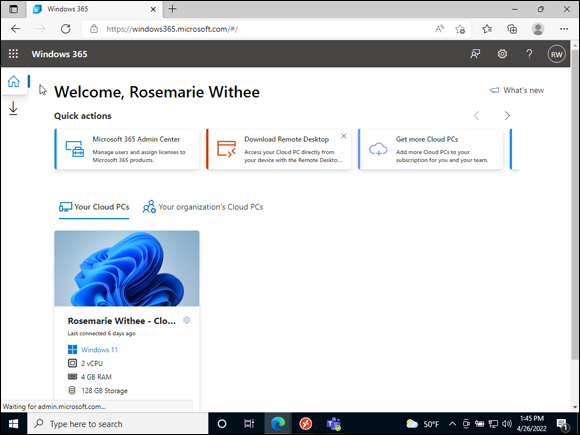
FIGURE 18-1: The main landing page of the Windows 365 administration site.
To give someone the Window 365 Administrator role so that they can administer cloud PCs in your organization:
-
Open your favorite web browser and go to
https://windows365.microsoft.com.The main landing page appears, as shown in Figure 18-1.
-
Click the tab to view your organization’s cloud PCs, as shown in Figure 18-2.
The page to manage the cloud PCs in your organization loads. On this page you can add users, reset passwords, and update your organizations settings.
-
Click the name of the person who you want to give the Windows 365 Administrator role.
A dialog appears on the right side of the page as shown in Figure 18-3.
 You can also block and unblock a user on this screen. If you suspect a user has had their password compromised or if you need to deactivate a person from signing in, you can block their sign-ins to the cloud PC. If the user is currently signed in, they will be signed out and won’t be able to sign in again.
You can also block and unblock a user on this screen. If you suspect a user has had their password compromised or if you need to deactivate a person from signing in, you can block their sign-ins to the cloud PC. If the user is currently signed in, they will be signed out and won’t be able to sign in again. - In the Roles section, click Manage Roles to view the current roles for the user.
- Select the Windows 365 Administrator role and then click OK.
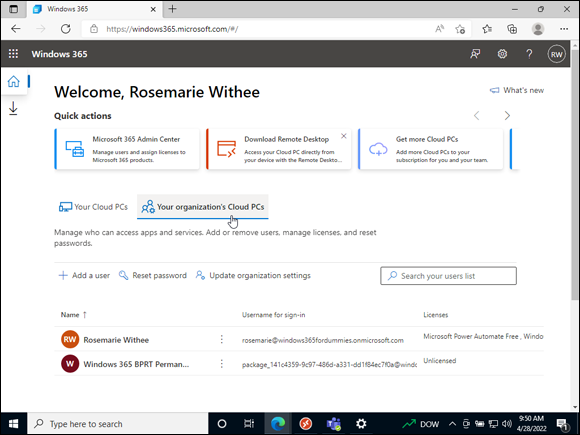
FIGURE 18-2: Selecting the tab to manage your organization’s cloud PCs.
Within the cloud PC a user can be a standard user or an administrator. By default, a user is a standard user in their cloud PC. If they need to install software other than from the Microsoft store and do other administration, then you can change the type of user account on the cloud PC to an administrator.
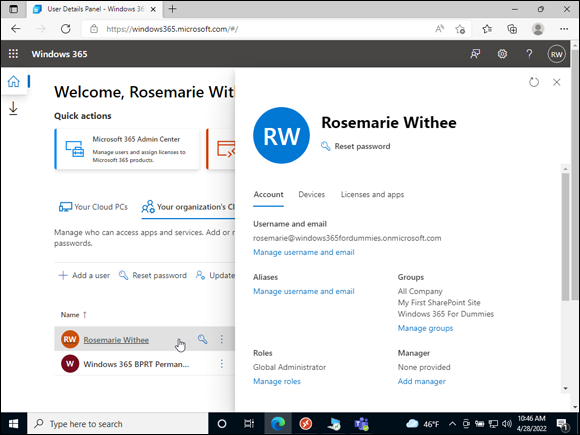
FIGURE 18-3: Dialog for a specific cloud PC user.
To change the account type of a user on their cloud PC:
-
Open your favorite web browser and go to
https://windows365.microsoft.com.The main landing page appears, as shown in Figure 18-1.
- Click the tab to view your organization’s cloud PCs as shown in Figure 18-2.
-
Click the name of the person whose account type you want to change for their cloud PC.
A dialog appears on the right side of the page, as shown in Figure 18-3.
- Click on the Devices tab and then click Change Account Type, as shown in Figure 18-4.
- Select either Standard user (recommended) or Local Administrator account and then click Confirm.
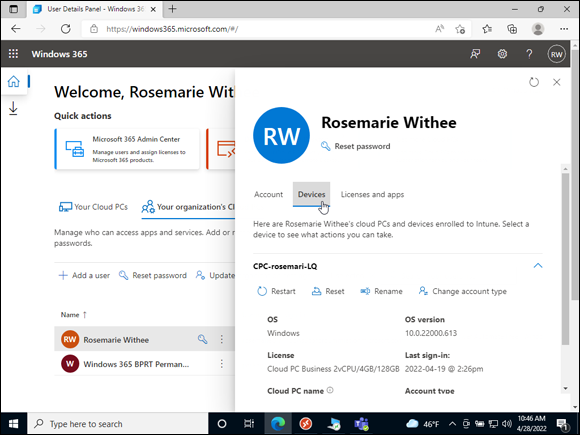
FIGURE 18-4: Viewing the devices for a user in the Windows 365 admin center.
Taking a look at the Microsoft 365 administration center
As discussed in Chapter 1, Microsoft launched Office 365 as a cloud first version of the traditional Office software. A cloud version of anything needs a place to manage it and the Office 365 admin center was born. Since then, Microsoft has rebranded parts of Office 365 to Microsoft 365. And the admin center has gone through, and continues to go through, many iterations and changes. You can find the latest version of the Microsoft 365 admin center at https://admin.microsoft.com.
Microsoft 365 and Windows 365 are closely tied together. The credentials you use to sign into your Windows 365 cloud PC come directly from the user you set up in Microsoft 365. The Microsoft 365 admin center is shown in Figure 18-5.
One of the main things you use the Microsoft 365 admin center for is managing users and subscriptions. You can add new users to your subscription and then purchase and assign them licenses, such as a Windows 365 license or license for the Office apps.
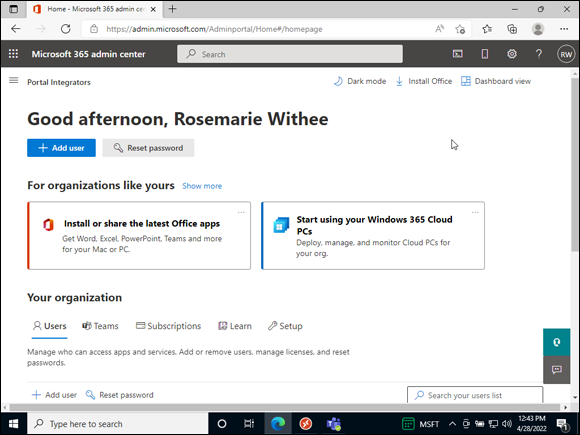
FIGURE 18-5: The Microsoft 365 administration center.
Digging into the heart of Microsoft services with Azure administration
Azure is at the center of all Microsoft products and services. Azure provides a computing platform that companies can build on and Microsoft uses the same platform to build products like Office 365 and Windows 365. You might never need to sign into the Azure administration site but you should know that it exists and that it is where you administer all things related to Azure. You can find the site at https://portal.azure.com and you use your Microsoft 365 credentials to sign in. The identity portion of Azure is where users and roles are managed, and you can find that by clicking on Azure Active Directory in the left navigation.
The Azure administration portal is shown in Figure 18-6.
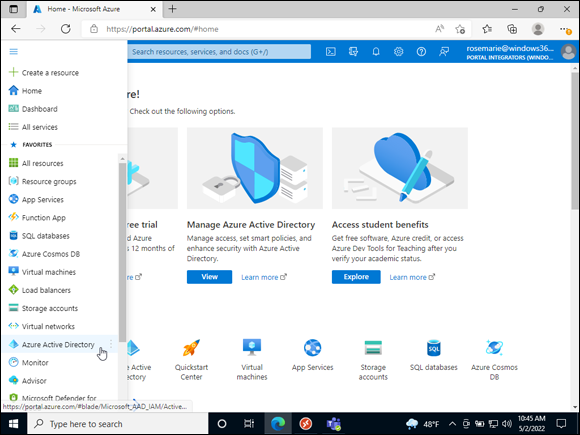
FIGURE 18-6: The Azure administration center.
Discovering administration centers for SharePoint and Teams
Some of the Microsoft services have their own administration centers. In Chapter 10 we discussed Microsoft Teams. This service has its own administration center you use to configure Teams settings for your organization. In Chapter 11 we talked about SharePoint. SharePoint is a content management system, and it also has its own administration center.
You find these service specific administration centers using links in the main Microsoft 365 administration center. Expand the left navigation in the Microsoft 365 administration center using the Show All option. Then scroll down to the Admin Centers section to view links to the service specific admin centers, as shown in Figure 18-7.
In the Teams admin site, you can manage teams, users, devices, apps, and many other things. Think of the Teams admin center as the “backend” of Microsoft Teams for your organization. Likewise, in the SharePoint admin center you manage sites, policies, settings, content services, and many other settings. Again, you can think of the SharePoint admin center as the “backend” of the SharePoint product for your organization.
The Teams admin center is shown in Figure 18-8 and the SharePoint admin center is shown in Figure 18-9.
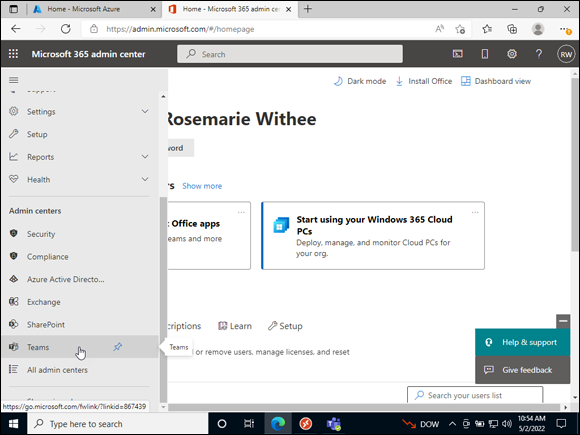
FIGURE 18-7: Finding links to the Teams and SharePoint admin centers from the Microsoft 365 administration center.
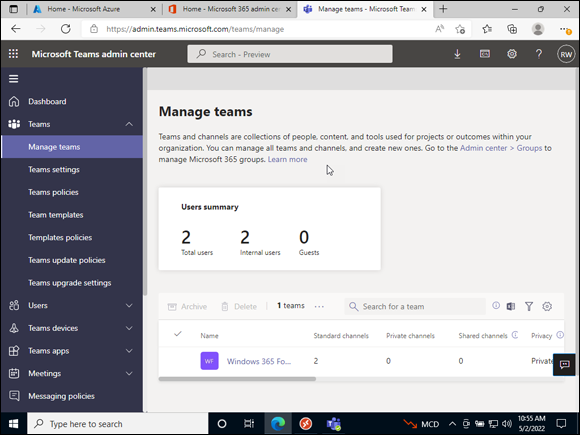
FIGURE 18-8: The Teams administration center.
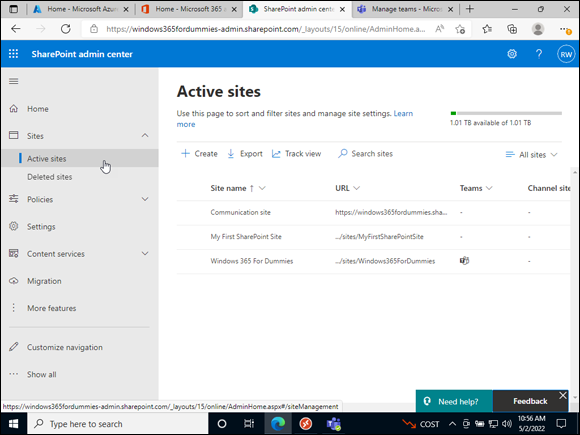
FIGURE 18-9: The SharePoint administration center.
Manage Cloud PCs from the Cloud
The good news is that all administration happens through websites and all you really need is a web browser. We like to think that the operating system is the final holdout in moving to the cloud. When the operating system, which is your cloud PC, is in the cloud you don’t have to worry about your physical computer anymore. Your physical computer is simply a means to connect and get work done. In other words, all administration and management for the cloud PCs in your organization happens in the cloud.
We are amazed at the development of new technologies and look forward to virtual reality and augmented reality devices that we can use to connect to our Windows 365 cloud PC. We also hope we live long enough to see direct brain interfaces such as the ones Neuralink is building.
The world is quickly moving into the realm of science fiction, and it can’t get here soon enough for us. Though it can be a bit scary to think about, it is exciting and awe-inspiring nonetheless!
Getting Help from Microsoft
With any new product it is common to run into issues and unforeseen problems. When you get stuck with something, you can open a support ticket with Microsoft and someone will contact you to get you moving. You open a support ticket in the Microsoft 365 portal. To open a support ticket, expand the Support option in the left navigation and then click New Service Request, as shown in Figure 18-10.

FIGURE 18-10: Opening a new support ticket in the Microsoft 365 portal.
Keeping Windows 365 Business and Enterprise Plans in Mind
When your organization adopts Windows 365, one of the big choices is between signing up for the Business plan or the Enterprise plan. We discussed these plans in Chapter 17 and in Chapter 2. If your organization needs to scale up the management of cloud PCs, meaning you have a lot of people who need a cloud PC, then you will likely want to go with the Enterprise plan.

 We recommend staying with the standard user type as much as possible. This reduces security concerns because only software that has been validated and vetted through the Microsoft store can be installed. Many organizations follow a best-practice policy that every user must be a standard user and any software installed beyond the Microsoft store must be checked by an IT department to reduce the risk of malware.
We recommend staying with the standard user type as much as possible. This reduces security concerns because only software that has been validated and vetted through the Microsoft store can be installed. Many organizations follow a best-practice policy that every user must be a standard user and any software installed beyond the Microsoft store must be checked by an IT department to reduce the risk of malware.